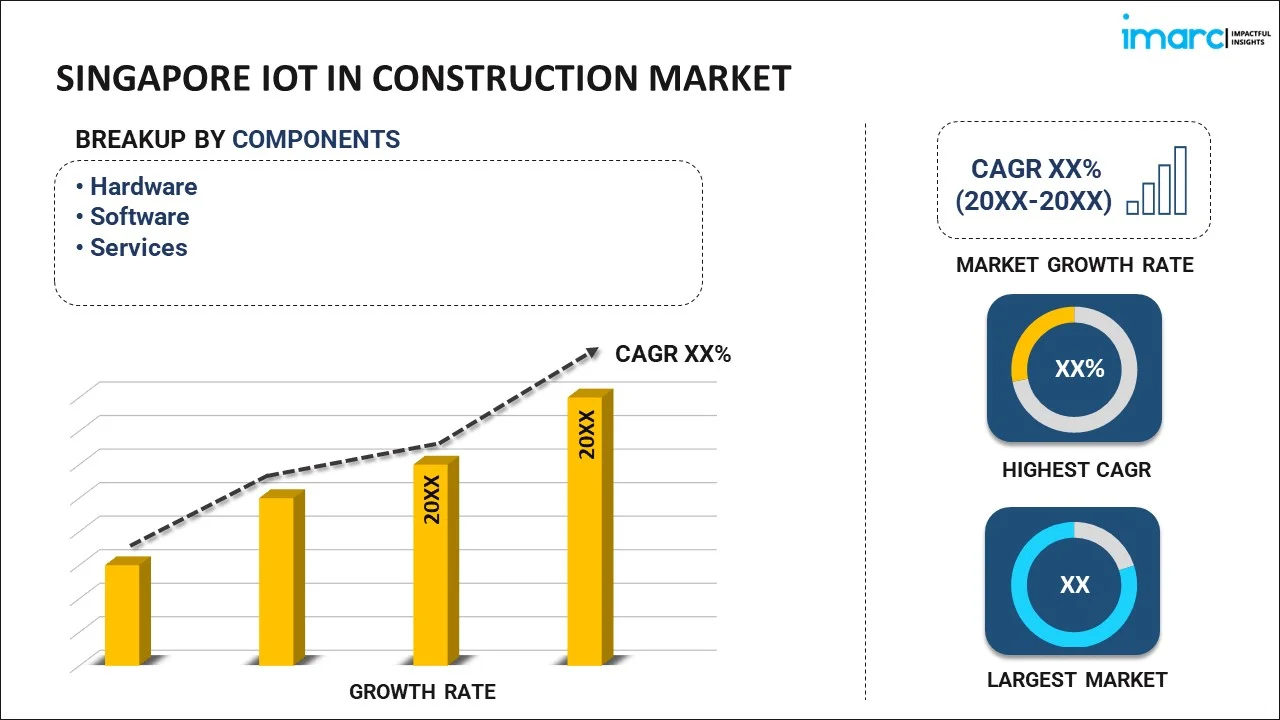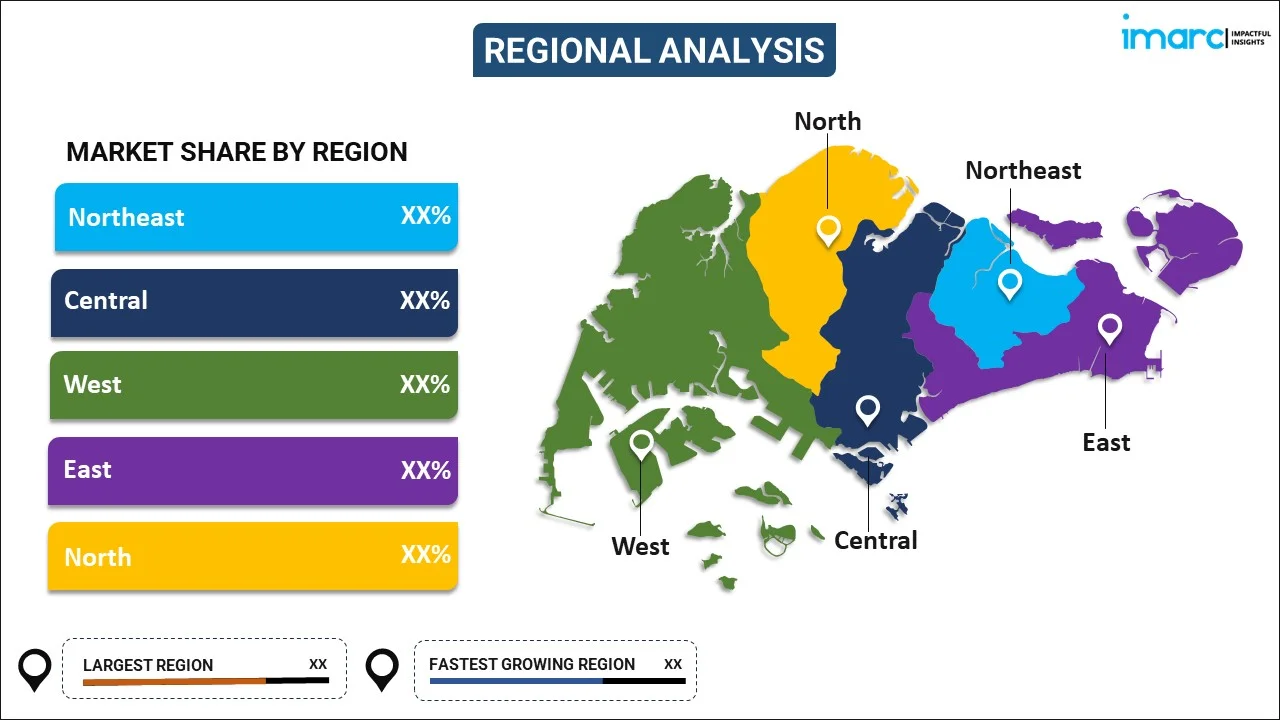
Singapore IoT In Construction Market Report by Component (Hardware, Software, Services), Application (Asset Monitoring, Predictive Maintenance, Fleet Management, Wearables, and Others), End User (Residential, Non-Residential), and Region 2024-2032
Singapore IoT In Construction Market Overview:
The Singapore IoT in construction market is projected to exhibit a growth rate (CAGR) of 15.20% during 2024-2032. The market in Singapore is majorly driven by an enhanced focus on project management with higher efficiency, continual improvements on safety and risk management, growing adoption of sustainable construction practices that emphasizes on quality control and assurance.
|
Report Attribute
|
Key Statistics
|
|---|---|
|
Base Year
|
2023 |
|
Forecast Years
|
2024-2032
|
|
Historical Years
|
2018-2023
|
| Market Growth Rate (2024-2032) | 15.20% |
Singapore IoT In Construction Market Trends:
Improved Project Management and Efficiency
The utilization of IoT in the construction industry in Singapore has greatly improved project management and efficiency. IoT devices enable organizations to access real-time construction data and analyze equipment utilization, workforce performance, and material availability. With real-time monitoring, project managers have visibility that can inform better choices faster, which means fewer delays and shorter project timelines. IoT sensors can monitor the usage and location of construction equipment to make sure resources are used as efficiently as possible and idle time is reduced. Similarly, project management platforms that are IoT enabled can help in better communication and coordination amongst various stakeholders, such as contractors, subcontractors and clients. By integrating data from different sources, these platforms offer a comprehensive view of the project status and can identify early-stage bottlenecks. This reaction-orientated style portioned the workflow within all parties, adversely impacting the quality of user-home interfaces which meant higher maintenance for both house owners and constructors.
Improved Safety and Risk Management
Wearable sensors, drones and smart cameras, are used as IoT devices in the field of worker safety monitoring and improvement. Wearable sensors can follow the vital signs of workers and the environmental conditions surrounding them, which can warn their supervisors of potential health threats, heat stress, or exposure from hazardous materials. Aerial inspections of construction sites. Drones fitted with cameras and sensors make short work of the immediate and remote surveying of progress, identifying and rectifying safety hazards, ensuring fit-for-purpose and that building regulations are being adhered to. In addition, safety systems in IoT can be an effective means for sending alerts and notifications in real-time during emergencies, allowing prompt responses to be taken, and for reducing the havoc created by accidents. Smart helmets, for instance equipped with sensors, can detect falls or impacts and immediately notify emergency services, ensuring timely medical assistance. While this focus on IoT for safety keeps workers safe, it also removes the financial and reputational risks that come with workplace incidents, and so is a key influence for driving the adoption of IoT in construction.
Sustainable Construction Practices
Sustainable construction practices sustainability is an escalating concern in the construction industry of Singapore and thus, IoT Technologies are supporting its advancements towards sustainable construction practices. Energy and water use, waste created and disposed of can be monitored using IoT devices on construction sites which then produce data that can be interpreted for optimizing resource use and reducing the environmental impact. Smart meters and sensors can monitor energy consumption in real-time to detect wastage and to encourage its fate by making energy-efficient activities. IoT technologies on the other hand can facilitate the reuse of sustainable building materials. IoT devices will give builders fine-grained information about where materials come from, how they are used, and how they have held up over time, so building companies can make smarter decisions when choosing construction materials that will help encourage the transition to green building practices. It is a necessity as legal and corporate regulations increasingly require sustainable processes, as do a growing number of customers and stakeholders who want to see sustainably built infrastructure.
Singapore IoT In Construction Market News:
- On 13th May 2024, airtel and google cloud entered a long-term strategic collaboration to accelerate cloud adoption and deploy generative AI solutions. The strategic collaboration will offer a suite of cutting-edge cloud solutions from google cloud to fast-track cloud adoption and modernization for Airtel’s customers.
- On 14th September 2023, Microsoft and oracle expanded partnership to deliver oracle database services on oracle cloud infrastructure in Microsoft azure. With the introduction of Oracle Database@Azure, the companies are helping customers accelerate their migration to the cloud, so they can modernize their IT environments and take advantage of azure’s infrastructure, tooling, and services.
Singapore IoT in Construction Market Segmentation:
IMARC Group provides an analysis of the key trends in each segment of the market, along with forecasts at the country level for 2024-2032. Our report has categorized the market based on components, application, and end user.
Component Insights:

- Hardware
- Software
- Services
The report has provided a detailed breakup and analysis of the market based on the component. This includes hardware, software, and services.
Application Insights:
- Asset Monitoring
- Predictive Maintenance
- Fleet Management
- Wearables
- Others
A detailed breakup and analysis of the market based on the application have also been provided in the report. This includes asset monitoring, predictive maintenance, fleet management, wearables, and others.
End User Insights:
- Residential
- Non-Residential
The report has provided a detailed breakup and analysis of the market based on the end user. This includes residential and non-residential.
Regional Insights:

- North-East
- Central
- West
- East
- North
The report has also provided a comprehensive analysis of all the major regional markets, which include North-East, Central, West, East, and North.
Competitive Landscape:
The market research report has also provided a comprehensive analysis of the competitive landscape. Competitive analysis such as market structure, key player positioning, top winning strategies, competitive dashboard, and company evaluation quadrant has been covered in the report. Also, detailed profiles of all major companies have been provided.
Singapore IoT in Construction Market Report Coverage:
| Report Features | Details |
|---|---|
| Base Year of the Analysis | 2023 |
| Historical Period | 2018-2023 |
| Forecast Period | 2024-2032 |
| Units | Million US$ |
| Scope of the Report | Exploration of Historical Trends and Market Outlook, Industry Catalysts and Challenges, Segment-Wise Historical and Future Market Assessment:
|
| Components Covered | Hardware, Software, Services |
| Applications Covered | Asset Monitoring, Predictive Maintenance, Fleet Management, Wearables, Others |
| End Users Covered | Residential, Non-Residential |
| Regions Covered | North-East, Central, West, East, North |
| Customization Scope | 10% Free Customization |
| Post-Sale Analyst Support | 10-12 Weeks |
| Delivery Format | PDF and Excel through Email (We can also provide the editable version of the report in PPT/Word format on special request) |
Key Questions Answered in This Report:
- How has the Singapore IoT in construction market performed so far and how will it perform in the coming years?
- What has been the impact of COVID-19 on the Singapore IoT in construction market?
- What is the breakup of the Singapore IoT in construction market on the basis of component?
- What is the breakup of the Singapore IoT in construction market on the basis of application?
- What is the breakup of the Singapore IoT in construction market on the basis of end user?
- What are the various stages in the value chain of the Singapore IoT in construction market?
- What are the key driving factors and challenges in the Singapore IoT in construction?
- What is the structure of the Singapore IoT in construction market and who are the key players?
- What is the degree of competition in the Singapore IoT in construction market?
Key Benefits for Stakeholders:
- IMARC’s industry report offers a comprehensive quantitative analysis of various market segments, historical and current market trends, market forecasts, and dynamics of the Singapore IoT in construction market from 2018-2032.
- The research report provides the latest information on the market drivers, challenges, and opportunities in the Singapore IoT in construction market.
- Porter's five forces analysis assist stakeholders in assessing the impact of new entrants, competitive rivalry, supplier power, buyer power, and the threat of substitution. It helps stakeholders to analyze the level of competition within the Singapore IoT in construction industry and its attractiveness.
- Competitive landscape allows stakeholders to understand their competitive environment and provides an insight into the current positions of key players in the market.
Need more help?
- Speak to our experienced analysts for insights on the current market scenarios.
- Include additional segments and countries to customize the report as per your requirement.
- Gain an unparalleled competitive advantage in your domain by understanding how to utilize the report and positively impacting your operations and revenue.
- For further assistance, please connect with our analysts.
 Inquire Before Buying
Inquire Before Buying
 Speak to an Analyst
Speak to an Analyst
 Request Brochure
Request Brochure
 Request Customization
Request Customization




.webp)




.webp)












